Abstract
OBJECTIVE--To determine the association between joint complaints and locomotor disability. METHODS--During a home interview survey 1901 men and 3135 women aged 55 years and over (the Rotterdam Study) were asked about joint pain and morning stiffness in the past month, and locomotor disability was assessed by six questions from the Health Assessment Questionnaire (HAQ). RESULTS--The prevalence of locomotor disability was 24.5% for men and 40.5% for women. The prevalence of joint pain in men was 0.7% for pain in the hips, knees, and feet simultaneously, 3.7% for pain at two joint sites, 16.0% for pain at one joint site, and 20.4% for pain in the hips and/or knees and/or feet (any joint site); the corresponding estimates for women were 1.9%, 9.0%, 23.7%, and 34.5%, respectively. The prevalence of generalised morning stiffness was 4.9% for men and 10.4% for women. The age adjusted odds ratios for locomotor disability in men ranged from 2.4 of pain at one joint site to 8.8 of pain at all three joint sites; for women these odds ratios varied between 2.5 and 5.7, respectively. The age adjusted odds ratios of generalised morning stiffness were 8.0 for men and 7.3 for women. CONCLUSION--There is a strong and independent association between locomotor disability and age, joint pain, and generalised morning stiffness in people aged 55 years and over. The odds for locomotor disability increase onefold for every year increase in age, while the presence of generalised morning stiffness is of greater influence than the presence of joint pain.
Full text
PDF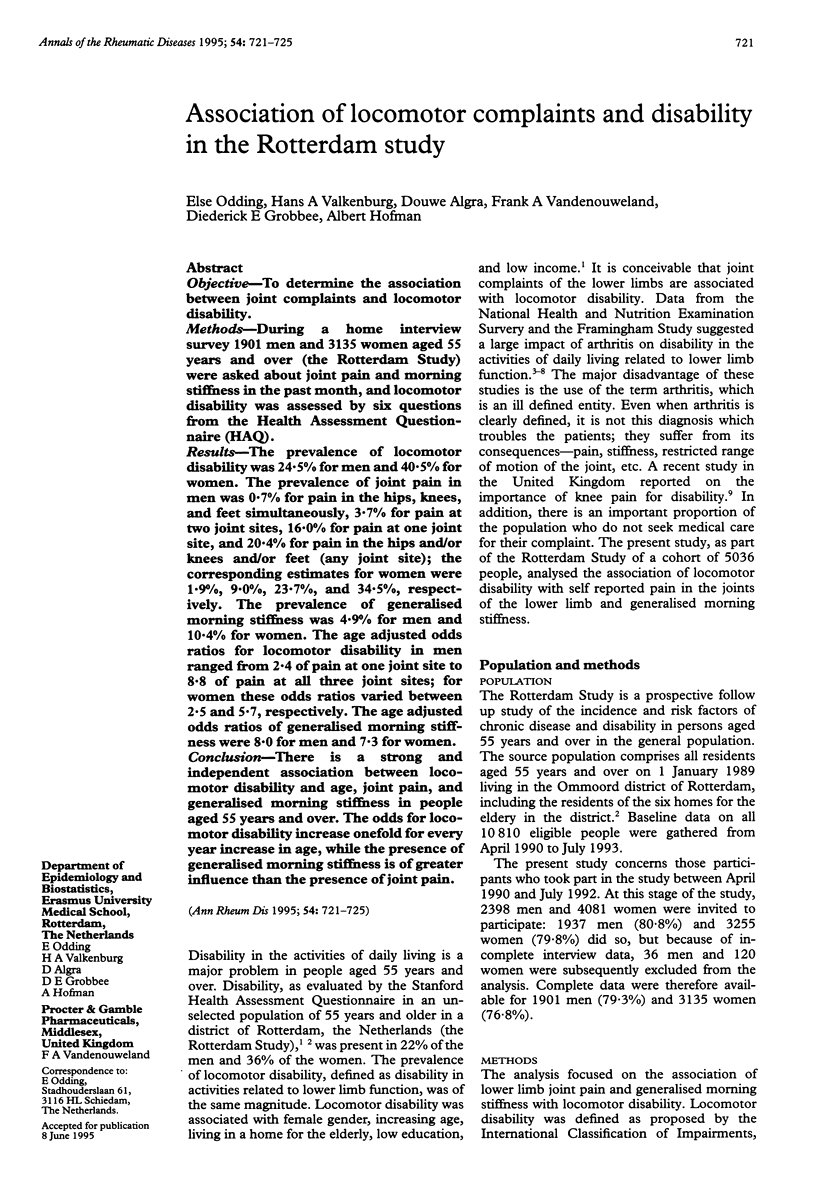
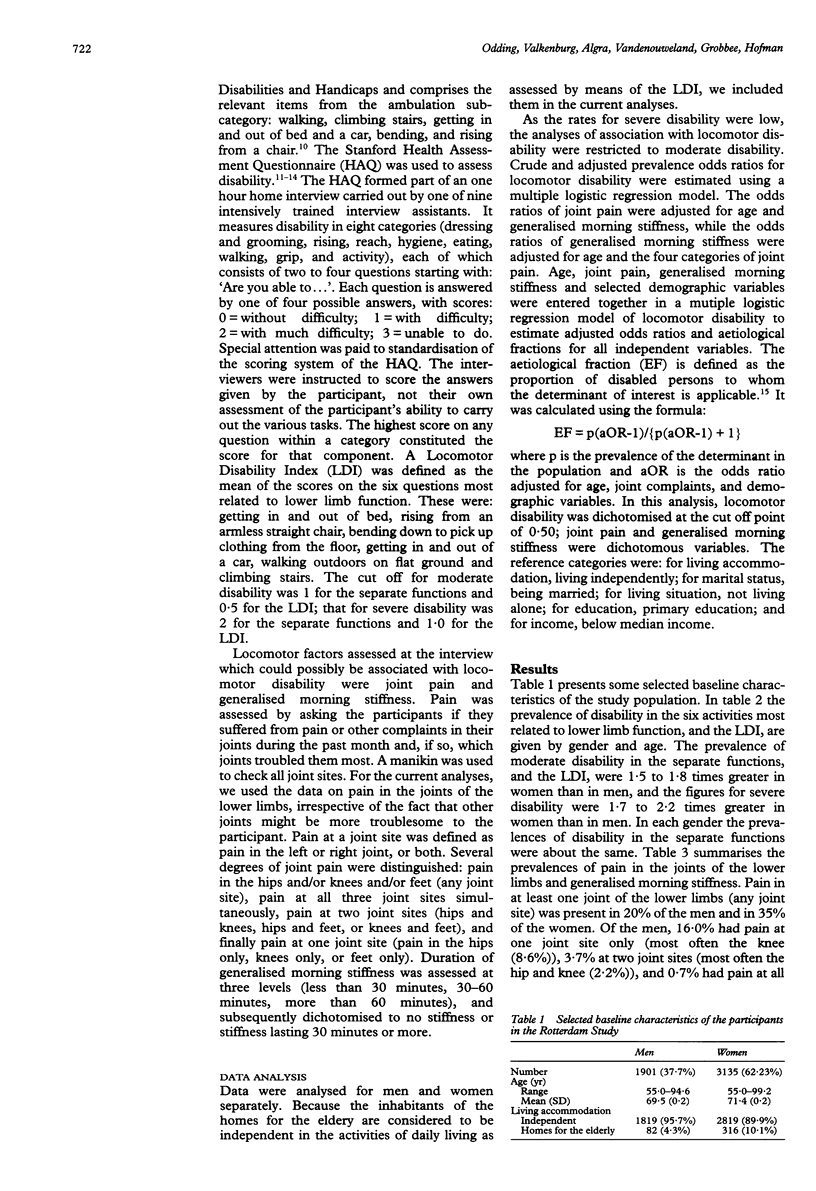
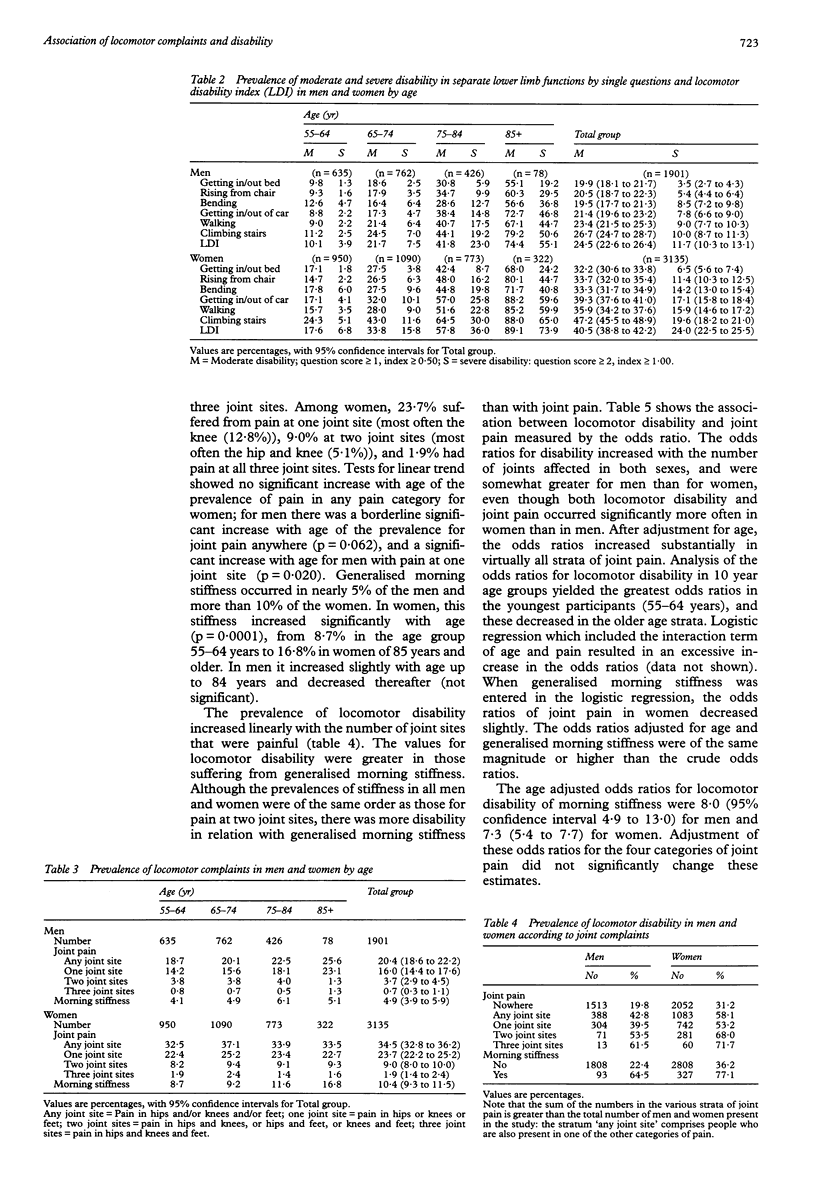
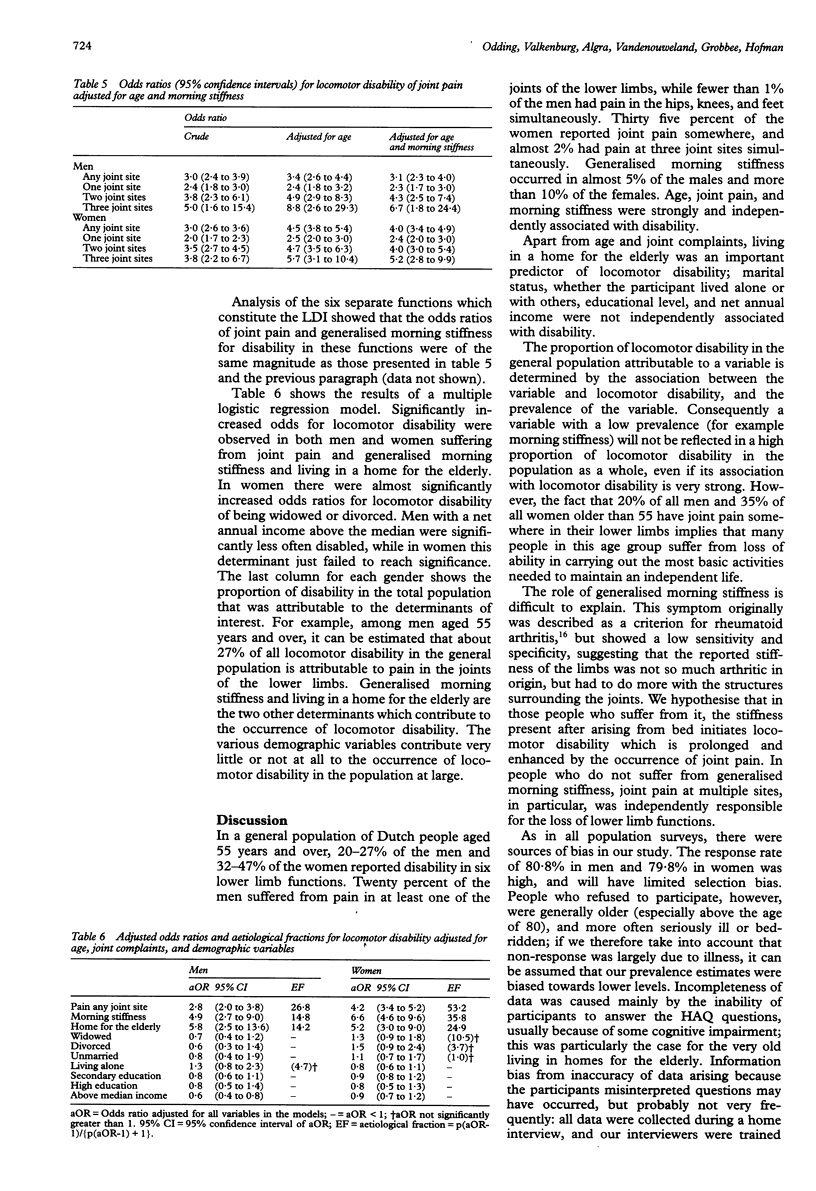
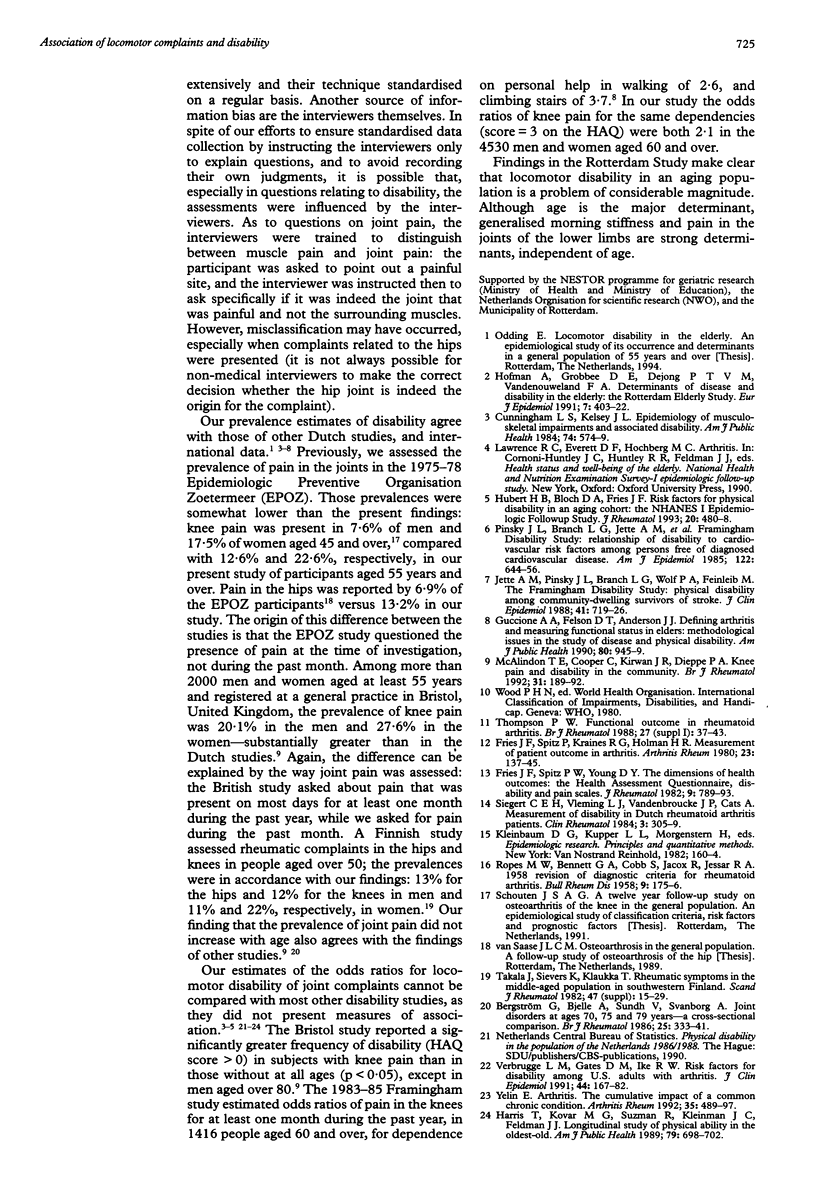
Selected References
These references are in PubMed. This may not be the complete list of references from this article.
- Bergström G., Bjelle A., Sundh V., Svanborg A. Joint disorders at ages 70, 75 and 79 years--a cross-sectional comparison. Br J Rheumatol. 1986 Nov;25(4):333–341. doi: 10.1093/rheumatology/25.4.333. [DOI] [PubMed] [Google Scholar]
- Cunningham L. S., Kelsey J. L. Epidemiology of musculoskeletal impairments and associated disability. Am J Public Health. 1984 Jun;74(6):574–579. doi: 10.2105/ajph.74.6.574. [DOI] [PMC free article] [PubMed] [Google Scholar]
- Fries J. F., Spitz P. W., Young D. Y. The dimensions of health outcomes: the health assessment questionnaire, disability and pain scales. J Rheumatol. 1982 Sep-Oct;9(5):789–793. [PubMed] [Google Scholar]
- Fries J. F., Spitz P., Kraines R. G., Holman H. R. Measurement of patient outcome in arthritis. Arthritis Rheum. 1980 Feb;23(2):137–145. doi: 10.1002/art.1780230202. [DOI] [PubMed] [Google Scholar]
- Guccione A. A., Felson D. T., Anderson J. J. Defining arthritis and measuring functional status in elders: methodological issues in the study of disease and physical disability. Am J Public Health. 1990 Aug;80(8):945–949. doi: 10.2105/ajph.80.8.945. [DOI] [PMC free article] [PubMed] [Google Scholar]
- Harris T., Kovar M. G., Suzman R., Kleinman J. C., Feldman J. J. Longitudinal study of physical ability in the oldest-old. Am J Public Health. 1989 Jun;79(6):698–702. doi: 10.2105/ajph.79.6.698. [DOI] [PMC free article] [PubMed] [Google Scholar]
- Hofman A., Grobbee D. E., de Jong P. T., van den Ouweland F. A. Determinants of disease and disability in the elderly: the Rotterdam Elderly Study. Eur J Epidemiol. 1991 Jul;7(4):403–422. doi: 10.1007/BF00145007. [DOI] [PubMed] [Google Scholar]
- Hubert H. B., Bloch D. A., Fries J. F. Risk factors for physical disability in an aging cohort: the NHANES I Epidemiologic Followup Study. J Rheumatol. 1993 Mar;20(3):480–488. [PubMed] [Google Scholar]
- Jette A. M., Pinsky J. L., Branch L. G., Wolf P. A., Feinleib M. The Framingham Disability Study: physical disability among community-dwelling survivors of stroke. J Clin Epidemiol. 1988;41(8):719–726. doi: 10.1016/0895-4356(88)90157-6. [DOI] [PubMed] [Google Scholar]
- McAlindon T. E., Cooper C., Kirwan J. R., Dieppe P. A. Knee pain and disability in the community. Br J Rheumatol. 1992 Mar;31(3):189–192. doi: 10.1093/rheumatology/31.3.189. [DOI] [PubMed] [Google Scholar]
- Pinsky J. L., Branch L. G., Jette A. M., Haynes S. G., Feinleib M., Cornoni-Huntley J. C., Bailey K. R. Framingham Disability Study: relationship of disability to cardiovascular risk factors among persons free of diagnosed cardiovascular disease. Am J Epidemiol. 1985 Oct;122(4):644–656. doi: 10.1093/oxfordjournals.aje.a114144. [DOI] [PubMed] [Google Scholar]
- ROPES M. W., BENNETT G. A., COBB S., JACOX R., JESSAR R. A. 1958 Revision of diagnostic criteria for rheumatoid arthritis. Bull Rheum Dis. 1958 Dec;9(4):175–176. [PubMed] [Google Scholar]
- Siegert C. E., Vleming L. J., Vandenbroucke J. P., Cats A. Measurement of disability in Dutch rheumatoid arthritis patients. Clin Rheumatol. 1984 Sep;3(3):305–309. doi: 10.1007/BF02032335. [DOI] [PubMed] [Google Scholar]
- Takala J., Sievers K., Klaukka T. Rheumatic symptoms in the middle-aged population in southwestern Finland. Scand J Rheumatol Suppl. 1982;47:15–29. [PubMed] [Google Scholar]
- Thompson P. W. Functional outcome in rheumatoid arthritis. Br J Rheumatol. 1988;27 (Suppl 1):37–43. [PubMed] [Google Scholar]
- Verbrugge L. M., Gates D. M., Ike R. W. Risk factors for disability among U.S. adults with arthritis. J Clin Epidemiol. 1991;44(2):167–182. doi: 10.1016/0895-4356(91)90264-a. [DOI] [PubMed] [Google Scholar]
- Yelin E. Arthritis. The cumulative impact of a common chronic condition. Arthritis Rheum. 1992 May;35(5):489–497. [PubMed] [Google Scholar]


